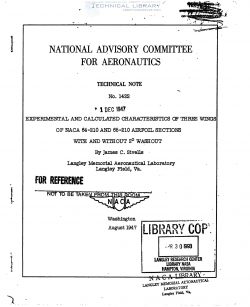naca-tn-1422
- Version
- 199 Downloads
- 867.78 KB File Size
- 1 File Count
- December 4, 2016 Create Date
- December 4, 2016 Last Updated
National Advisory Committee for Aeronautics, Technical Notes - Experimental and Calculated Characteristics of Three Wings of NACA 64-210 and 65-210 Airfoil Sections With and Without 2° Washout

An investigation has been conducted to determine some of (the .
effects of airfoil section and. washoutI- on the experimental and _.
calculated characteristics of lO-perce'nththick wings. I'I'hree wings.
of aspect ratio 9 and ratio of root chord to tip 'tho'rd, 2 .5 were, tested.
One wing had. lit-163A 64-310. sections and 2° washout the second had I _ _
NACA- 6-5-210 sections a:4:1d-_go washout, and” the third. had" NACA I65-210.
sections and O<5 washout. __/' It was found that the experimental '
characteristics of the wings could be satisfactorily predicted. from
calculations based upon two-dimensional data. when the airfoil contours
of the wings conformed to the true airfoil- sections with the same
high degree of accuracy as the two-dimensional model‘s. Small
construction errors were found to cause large discrepancies in the .-
values of maximun lift coefficient}. The 'most significant effect of . .
changing the airfoil section from an NADA 65-210 section to an
NACA Sip-210 section was to increase the maximum lift "coefficient by
about 10 percent, although the abruptness of the stall was also
increased. The addition of 2° washout to the NAGA 65-210 wing
increased. the angle of. attack for 'zero lift as expected. but was
not sufficient to improve materially the stalling characteristics
Il‘he other characteristics of the wings were essentially. unaffected.
by the change in airfoil section or by the addition of washout.
One means of increasing the critical speed. of an airplane wing
is to decrease the thickness of the airfoil sections. Decreasing
the airfoil thickness below about 12 percent, however, reduces the.
maximum lift coefficient of the section (reference 1), ”furthermore,
the use of thinner airfoil sections increases the structural problems
encountered in the airplane design. As is usually the case in _
airplane design, some compromises must be made between these conflicting
deeiderations. For example, an airfoil thic'imess of 10 percent-
represents a reasonable compromise between the aerodmmic and
structural considerations involved in the design of a long-range,
high-speed airplane.
| File | Action |
|---|---|
| naca-tn-1422 Experimental and Calculated Characteristics of Three Wings of NACA 64-210 and 65-210 Airfoil Sections With and Without.pdf | Download |

Comment On This Post